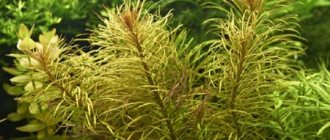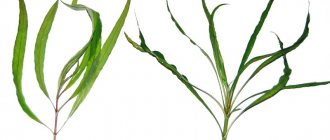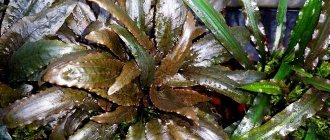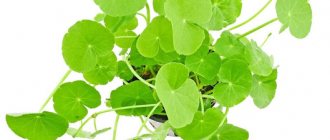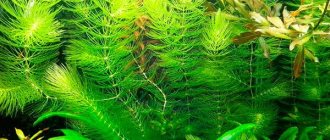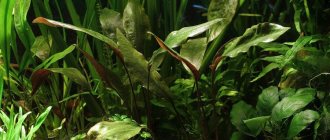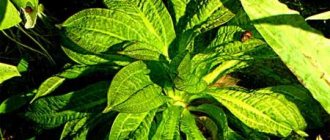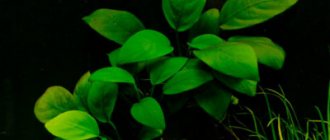Echinodorus tenderus or “Dwarf Amazon” is very popular among aquarists: from beginners to avid lovers of the underwater world at home. The plant received its second name “Gentle” due to its ability to form bushy thickets , reminiscent of a soft fleecy covering lined along the bottom of the aquarium. The plant has bright green elongated leaves about 5 cm long; bushes rarely grow more than 10 cm in height. The leaf blade is narrow to 0.5 cm at the rhizome, wide in the middle and pointed towards the end of the leaf. The leaves come from a small rhizome, which has a fragile structure and is sensitive to frequent transfers from one part of the aquarium to another.
Description
Belongs to the chastukha family. A related species is Echinodorus tender rubra. This species is distinguished by its unpretentiousness in maintenance, compared to its close relatives. Echinodorus rubra is a taller plant (up to 17 cm in height) and has thinner leaves. A distinctive feature of Echinodorus rubra is the purple color of the leaves.
Content
Difficulty in content . This aquarium species is not demanding in terms of maintenance, so it is often chosen by beginning aquarists. The only important requirement is to provide high-quality lighting and water filtration. Otherwise, the plant will slow down its growth, lose color and wither. In all other respects, this species does not differ in demandingness from other inhabitants of aquariums.
Requirements for an aquarium . Echinodorus is low (up to 10 cm), so it is advisable to select a tank with low walls for optimal light transmission through the water column. A size of 25-45 cm is the ideal height of the aquarium walls for the comfortable growth of Echinodorus. The area of the bottom of the aquarium depends on the owner of the aquarium: the more bushes you plan to plant, the larger the area of the aquarium should be.
Soil . A fine, well-silted substrate, 1 to 3 cm thick, is suitable. A thick layer of soil is not necessary, since the rhizome is fragile and small. If you choose soil consisting of large stones, for example pebbles, Echinodorus will grow unevenly and sparsely, which will spoil its decorative qualities.
Environment Settings . Echinodorus does not require special maintenance of the water composition. A comfortable environment for Echinodorus will be created by water at room temperature 22-25°C, with hardness parameters of 6-16 °dH (medium hardness) and acidity from 6 to 8 Ph. Too soft water will have a detrimental effect on bushy foliage and it will quickly lose its volume. If the water is too cold, the plant may slow down its growth or die. The plant does not tolerate a dirty pond; the water must be changed in parts (no more than a third of the total volume at a time) once a week.
Lighting . Echinodorus is sensitive to light. The plant needs a large amount of light, both natural and artificial. It is not recommended to expose it to direct sunlight, as it can easily damage the delicate leaves of the plant. Sunlight should be diluted with a houseplant or curtain in front. At night, natural light can replace low or medium power fluorescent lamps (0.5 W/l). If Echinodorus does not receive enough light, its dense, bright green thickets will lose their color and shape. The leaves will become more elongated and thinner, as they will be drawn towards the light source. The plant must be illuminated for at least 12 hours a day.
Filtration . The plant will grow better in well-purified water. Muddy, dirty water is not able to transmit enough light through it. And since the Echinodorus plant does not grow tall, light will pass to its foliage from top to bottom only when the water is completely transparent and there are no floating particles of dirt, food or algae.
The video shows a plant in an aquarium
Echinodorus tender
Echinodorus tender tenellus photo
Range – North and South America. Echinodorus tenellus, also known as the herbaceous Echinodorus, is a herbaceous plant of the genus Echinodorus of the family Partisaceae, also known among aquarists as the “dwarf Amazon”.
Thickets of Echinodorus tender are 7-10 cm high. Echinodorus tender is popular among aquarists due to its unpretentiousness to living conditions and high decorative qualities.
Echinodorus tender tenellus photo
Comfortable water parameters for keeping Echinodorus tender : temperature 24-26 ° C, hardness - more than 4 °, Echinodorus feels better in a neutral and slightly alkaline environment. It is advisable to change the water regularly.
This echinodorus requires powerful lighting from 70 Lm/l, at which the plant acquires a bright color, the bushes become low and dense. The duration of daylight hours is from 8 to 12 hours, depending on the power of the illuminators.
Echinodorus tender tenellus photo
Tenellus grows well in nutritious soil. The substrate is coarse sand. A layer of soil from 3 cm. Mineral fertilizing is required only in a very densely planted aquarium.
Reproduction is easy. The mother bush forms 2-3 tendrils, on which young plants appear one after another. Such a mustache can be separated and planted in a new place.
PS It is worth distinguishing Echinodorus tenellus from rubra - these are two different plants.
Echinodorus gentle video review
Cool videos about plants and herbalism from FanFishki
Subscribe to our YouTube channel so you don't miss anything
PRACTICAL NOTE ON GROWING AQUARIUM PLANTS
This note is posted in all FanFishka articles dedicated to aquarium plants. This is a cheat sheet with a link that will help you grow any aquarium plant and herbalist of any complexity.
Most of the reference materials are located in the Aquascape , we also recommend our brochure: Aquarium navigator for beginners: “Underwater Gardens of Babylon” .
The formula for success in growing plants can be depicted as follows.
First of all, the proper level of lighting is necessary.
(light intensity - Lumens)
Next, the proper concentration of CO2
Further macro-fertilizers and micro-fertilizers
Water parameters, care and quality water changes
The gradation of this formula is based on the degree of importance. Lighting intensity is primary, and then descending. Therefore, if your plants have holes in the leaves, they have sciatica (crooked) or there are problems with algae, then please do not read the “bad advice” - this is chlorosis (lack of iron), this is a lack of potassium... diarrhea, phimosis and endometriosis )
You always need to solve the problem of setting up an herbalist from major to minor. Plants will die more quickly from a lack of lighting than from a lack of Fe and K. Moreover, the latter are always present in one degree or another in the aquarium, but it is difficult to measure their precise value.
Below, let's go from the main to the minor.
Lighting in an aquarium with plants . Remember, the most important thing in light is its intensity (Lumens)! All other lighting characteristics: spectrum, Kelvin, PAR/PAR, Ra... are important, but secondary. There will be no intensity of lighting, there will be nothing. At the same time, the lighting intensity must be balanced - selected specifically for your project (height of the water column, number and types of plants, daylight hours).
Based on the above, choose aquarium lighting primarily by the number of lumens, and then everything else.
Lighting is the most expensive part. The most budget-friendly solution is to install ordinary construction-street floodlights above the aquarium . Fortunately, they are now very thin and aesthetic. And believe me, under them everything grows with a bang, of course, provided that all the other components are present.
In order not to be unfounded, here are photos of our herbalists, which were grown exclusively under LED spotlights or with their presence.
If you want professional lighting or aesthetics. Then you will have to fork out some money. The amounts can vary quickly from 10,000 to 50,000+ rubles for a 100 liter aquarium. It’s difficult to advise anything, because... Everyone has different needs and capabilities. In this article we talk about the products of our partners - Tetra , Laguna , ISTA lighting .
We tried to briefly and objectively talk about them. Then it's up to you. In any case, we do not really recommend that you pay attention to handicraft lighting assembly from folk craftsmen. Not all, but as a rule, they shove who knows what kind of diodes into such an assembly, assemble it all on their knees... and believe me, more than once on the forum you hear echoes of the consequences of such a purchase. After all, a company is a company. At a minimum, you are given warranty and post-warranty service.
If you are a beginner, your first herbalist, then LED spotlights are your choice. Let's move on, otherwise this note isn't very short =)
CO2 for aquarium plants . The plant is approximately 90% water, the remaining 10% is dry matter. Of that 10%, 46% is carbon. This is why CO2 supply is so important in a planted aquarium.
Plants in an aquarium obtain carbon “from water” - from carbon-containing compounds. But the natural concentration of C-carbon in water is small and is only sufficient for unpretentious plants, but they, and even more so, will be happy with additional carbon feeding. The supply of CO2 can be provided using mash or a CO2 balloon system , lemon juice or other methods.
The best, professional, simple and budget option is to supply carbon dioxide through a cylinder. One thing, however, is the initial purchase of a set: a cylinder, an MG valve, a diffuser…. will hit the budget.
Is it possible to do without CO2, but for a couple of bushes of simple plants ( cryptocorynes , echinodorus , most ludwigias , etc.).
What balloon systems can you recommend? The most budget option is an assembly from craftsmen who sell CO2 systems in VK and on forums. Everything is very high quality.
If you want a branded item, then we recommend the most inexpensive and at the same time high-quality CO2 systems from ISTA (Taiwan) . We have been using them for 5 years and recommend them to you.
On sale you will find two series of ISTA Aluminum CO2 Cylinder cylinders, with horizontal and vertical threads of 1 and 3 liters.
Fertilizers for an aquarium with plants . All fertilizers, of any brand, can be divided into MACRO-FERTILIZERS and MICRO-FERTILIZERS .
Macro fertilizers are nitrate NO3 and phosphate PO4 from which plants take N-nitrogen and P-phosphorus. These are the most important elements after CO2 - C-carbon.
Remember - Redfield's proportion rules . Always keep it under control and everything will be ok. Right, based on our observations, Redfield’s proportion rules only in full NPC proportions. Incomplete proportion - without carbon C does not give good results.
Micro fertilizers . These are all the other less important elements that are necessary for plants (see link). There is no point in putting too much emphasis on them. Firstly, all of them are contained in one quantity or another in tap water and are restored in the aquarium with changes. Secondly, an overdose of micro very quickly leads to an outbreak of algae.
A common mistake made by beginners is not understanding what they are pouring into the aquarium. For example, let's take such a popular and popular fertilizer as Tetra PlantaMin . Read the product summary at the link - it strengthens, stimulates, and gives a chic body shape.
A beginner, without delving into the essence, uses it and gets an outbreak of algae, writes on the forums - “Like, wow, what a bad Tetra.” And the trouble lies not in the drug, but in a lack of understanding of the nitrogen cycle and balance in the herbalist . The beginner has a Redfield bias (let’s say N and P are generally zero) and instead of making up for the lack of these primary elements, he fills the aquarium with Tetra PlantaMin - a micro-fertilizer (iron, potassium, manganese). As a result, going over the micro is only detrimental, because... plants lack the base - nitrogen and phosphorus.
Thus, you must understand what plants lack and understand fertilizers.
How to understand what plants lack? It's simple. Now the market is filled with a variety of expensive and not so expensive aquarium water tests. We recommend inexpensive domestic ones - VladOx drop tests , they are sold online and offline.
We also recommend, let’s not be afraid of this word, innovative domestic UHE tests . They are currently only sold online.
The minimum set of tests for an herbalist is NO3 and PO4. It is advisable to have the entire nitrogen range: NH4, NO2, NO3. As well as kH and pH tests.
Tests help us monitor the situation in the herbalist, but over time it is advisable to learn to see and feel the aquarium for yourself. With experience you need to move away from “convulsive testing”; the best aquarium test and tool is ourselves.
Let's summarize this part. Macro, it’s macro in Africa too. The link above generally contains a recipe on how to make them yourself. If you are not yet ready for self-mixing, then always and everywhere you will find a line of fertilizers from Tetra: Tetra Planta Macro , Tetra PlantaMicro , substrates, root tablets and much more .
Of course, there are many other brands that produce aquarium fertilizers. There is an opportunity, use even ADA products. All markers are different in taste and color. The main thing is to use it with a clear understanding of what you are using it for and what you want to get in the end.
From the professional line of fertilizers, at an adequate price, we can recommend Prodibo (soils, soils, macro, micro, stimulants, etc.).
So, something like a note turns into the Talmud. Which is not surprising - the topic is very broad. One moment left.
Water parameters for aquarium plants. Link1 and Link2 , please look at these articles, they cover the essence quite well.
Here we note that the quality of photosynthesis is influenced by the process of caring for the aquarium: water parameters (kH, pH below 7), high-quality filtration and aeration, competent and timely water changes.
Please study
How to plant a plant?
Adding mineral supplements or nutrient bedding is not necessary, as the plant will eventually obtain the necessary trace elements from the silt soil. Before planting the plant in a community aquarium, it is necessary to quarantine it in a separate container with new soil for up to one week. When planting, you need to dig a shallow hole in the ground and carefully place the fragile root system of Echinodorus into it. Another option (more gentle) would be to replant from quarantine together with soil to which the Echinodorus has become accustomed and has become saturated with beneficial microflora. It is better to plant bushes closer to the walls of the aquarium, since in this case it will be easier to provide side lighting.
Breeding
In an aquarium, Echinodorus tender reproduces vegetatively. 2-3 weeks after transplanting the plant into the aquarium, with good soil and sufficient lighting, the plant bush produces several tendrils with new young shoots. It is recommended to separate the daughter shoots from the mother after the formation of 3-5 leaves. After separation, it is necessary to place the new shoot in the ground for further growth. In addition to vegetative propagation, it is capable of dispersing seeds, which grow well in silty soil saturated with minerals.
Plant propagation
Reproduction of Echinodorus occurs vegetatively. Already 3 weeks after planting, the first tendrils appear on it, and new shoots gradually form at their ends. You should wait until 3-5 leaves bloom on the shoots, then the plants are propagated by shoots. After this, the landing procedure described above is used.
Echinodorus can reproduce by seeds. If you plant them in a muddy substrate, they germinate quickly.
When propagated on land, Echinodorus tender thrives in the humid conditions of a greenhouse, where it blooms and produces full-fledged seeds, and in a terrarium. When flowers appear, they need to be pollinated with a soft brush. After 1.5-2 months, the seeds ripen and can be germinated in sand filled with water.
Bookmarks 0
Diseases, their treatment and prevention
Gentle Echinodorus can get sick only due to the human factor and improper care. Too much natural or artificial light can burn delicate leaves, causing them to become yellow, damaged and soon wither. This situation can only be prevented by carefully selecting the location of the aquarium and the power of artificial lighting lamps. Too coarse rocky soil will limit the nutrition of the plant's rhizome with beneficial microelements and the plant may die. It is not recommended to stock fish that can feed on fresh leaves of aquarium plants. Such fish are able to feast on decorative plantings even with timely feeding. If the aquarium has been attacked by a fungus, it is necessary to quarantine the bush and thoroughly wash the soil. Such actions are a necessary measure and put stress on the plant. After such procedures, it is recommended to further enrich the prepared soil with useful microelements.
Average price and where can you buy it?
It is necessary to purchase aquarium plants in specialized stores. When buying Echinodorus from hand, there is a risk of introducing infection or parasitic species into the aquarium with uncontrolled reproduction. The average price for one bush is about 150 rubles .
Echinodorus tender will fit perfectly into the decoration of the aquarium due to its small size. It is better to plant this plant in the foreground and trim the long leaves from time to time. This way you can achieve the effect of a lush green carpet that will decorate the small underwater world of your aquarium. The main thing to remember is that high-quality lighting and well-silted soil are the key to success for growing Echinodorus tender.
Care
Both varieties of Echinodorus tender, “green” and “rubra,” are best used as ground cover varieties for a large aquarium. In small tanks they can be kept to form emerald green islands along the side walls and in the middle of the composition. These varieties are unpretentious underwater plants, so they can be grown even in low light without fertilizers, on practically “bare” sandy soil.
The rosette of Echinodorus Gentle forms powerful roots as it grows, and responds well to the addition of nutritious balls from ordinary soil for indoor flowers under the root system of a young plant. With such a nutritious substrate, the period of adaptation of the plant to new conditions will pass faster, it will grow well and throw out runners.
Both varieties of Echinodorus “Tender” and “green” and “rubra” love light; the brighter the lighting in the aquarium, the more decorative and attractive they look, the brighter the “lime” or burgundy color of the leaves and the denser they grow. The optimal light level for this plant will be 0.5 W/l.
The most favorable temperatures for growing Echinodorus “tender” are +180C - +300C. It grows well in water of any hardness and can perfectly adapt to pH levels of 6.0 – 8.0. The most common of the Echinodorus varieties, “gentle”, due to its decorative properties and miniature size, bright color and ability to grow quickly, has rightfully become one of the favorite varieties for the aquarium.




